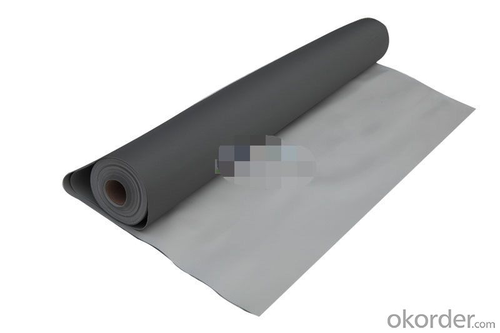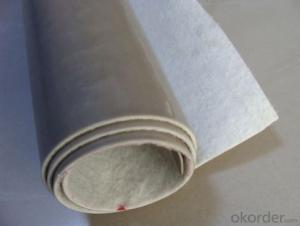Polymeric PVC Waterproof Coiled Membrane
- Loading Port:
- China main port
- Payment Terms:
- TT OR LC
- Min Order Qty:
- 5000 g/m²
- Supply Capability:
- 100000 g/m²/month
OKorder Service Pledge
OKorder Financial Service
You Might Also Like
1.Structure of Polymeric PVC Waterproof Coiled Membrane Description:
Polyvinyl chloride (PVC), polymer waterproofing material is used PVC resin,adding plasticizer, anti-uv agent, anti-aging agent, stabilizer, imported additives, made by pressure surface technology . Benzene product uses a unique product formulations.Product life is better than that of general waterproof material.And it can have the same life with building life, to a wide range of application in construction and civil engineering.
The products according to the presence of composite layer are divided into N class (no composite layer), L (single fiber composite) and W (fabric enhanced).Each type according to the physical and chemical properties is divided intoⅠtype and Ⅱ type.The thickness is of 1.0 mm, 1.5 mm and 2.0 mm.
2.Main Features of Polymeric PVC Waterproof Coiled Membrane:
•High tensile strength,high elongation, heat treatment size changes small;
•Good low temperature flexibility, adapting to changes in environmental temperature difference;
•Resistant to root permeability is good, it can make it planting roof;
•Long service life and good performance for aging resistance; Welding construction, firm,reliable,no environmental pollution;
•Chemical corrosion resistance is strong
•Good plasticity,
•Convenient for maintenance and low cost.
3.Polymeric PVC Waterproof Coiled Membrane Specification:
| Size | 2.05(width)*20m (length) | |||
| Thickness | 1.2mm | 1.5mm | 2.0mm | |
| Type | Homogeneous | Reinforced | Fabric Bank | |
| Color | white | Grey or customized | ||
4.Polymeric PVC Waterproof Coiled Membrane Images:

- Q: Are waterproofing membranes resistant to mold and mildew?
- Yes, waterproofing membranes are resistant to mold and mildew. They create a barrier that prevents moisture from seeping through, which helps inhibit the growth of mold and mildew.
- Q: Can waterproofing membranes be used on swimming pool decks?
- Yes, waterproofing membranes can be used on swimming pool decks. Waterproofing membranes are designed to create a barrier against water penetration, making them an ideal solution for areas that are constantly exposed to water, such as swimming pool decks. By applying a waterproofing membrane to the deck surface, it helps to prevent any water from seeping through and causing damage to the underlying structure. Additionally, waterproofing membranes can also provide protection against chemicals, UV rays, and general wear and tear, which are common in swimming pool environments. Overall, using waterproofing membranes on swimming pool decks can help extend their lifespan, reduce maintenance costs, and enhance the overall safety and appearance of the area.
- Q: Can a waterproofing membrane be used for parking garage ramps and driveways?
- Yes, a waterproofing membrane can be used for parking garage ramps and driveways. It serves as a protective barrier against water infiltration, preventing damage to the underlying structure and extending its lifespan.
- Q: Can a waterproofing membrane be installed on any surface?
- When installing a waterproofing membrane, there are several factors to take into account. The condition and composition of the surface, as well as the type of membrane being used, determine its suitability. Typically, waterproofing membranes are designed to adhere to various substrates like concrete, wood, metal, and masonry. They can be applied to surfaces such as roofs, foundations, basements, bathrooms, and balconies. However, it is crucial to ensure that the surface is clean, dry, and free from contaminants like dirt, debris, or loose materials before installing the membrane. In addition, certain surfaces may require additional preparatory work or primers to enhance adhesion and ensure a long-lasting waterproofing solution. For example, rough or uneven surfaces may need to be leveled or smoothed before applying the membrane. The specific requirements of the waterproofing system being used should also be considered. Different membranes have different application methods and compatibility with surfaces. Some membranes may be more suitable for horizontal surfaces like flat roofs, while others may be better suited for vertical surfaces like walls or foundations. Ultimately, it is recommended to consult a professional waterproofing contractor or refer to the manufacturer's guidelines to determine the compatibility of the membrane with a specific surface and ensure proper installation for optimal performance and longevity.
- Q: Can a waterproofing membrane be used on precast gypsum surfaces?
- Yes, a waterproofing membrane can be used on precast gypsum surfaces. This membrane acts as a barrier to prevent water penetration and can be applied to protect the gypsum surface from moisture damage.
- Q: Can a waterproofing membrane be used for bridge abutments?
- Bridge abutments can be safeguarded using a waterproofing membrane. These membranes are commonly utilized in the construction industry to safeguard structures from moisture damage and prevent water infiltration. Due to their close proximity to water bodies and potential exposure to groundwater, bridge abutments are particularly at risk of water damage. The application of a waterproofing membrane on bridge abutments serves as a protective barrier against water penetration, effectively shielding the structure from potential harm. To ensure comprehensive protection, the membrane is typically installed on the abutment walls and extends below ground level. Waterproofing membranes are designed to be both durable and flexible, enabling them to withstand movement and settling that may occur in bridge abutments. Materials such as bitumen, PVC, or modified bitumen are commonly used to create these membranes, as they offer exceptional resistance to water and other environmental factors. By incorporating a waterproofing membrane on bridge abutments, engineers and contractors can guarantee the structure's longevity and safety. It effectively mitigates moisture-related issues, including concrete deterioration, corrosion of reinforcing steel, and the emergence of cracks and leaks. Furthermore, the membrane can serve as a vapor barrier, reducing the likelihood of condensation and moisture buildup within the abutments. In conclusion, waterproofing membranes provide an effective solution for safeguarding bridge abutments against water damage. They establish a dependable barrier against water penetration, ensuring the structural integrity and longevity of the bridge.
- Q: Can a waterproofing membrane be applied over existing waterproofing layers?
- Yes, a waterproofing membrane can be applied over existing waterproofing layers. However, it is important to assess the condition of the existing layers to ensure they are sound and can provide a proper substrate for the new membrane. Additionally, proper surface preparation and compatibility between the existing layers and the new membrane should be considered to ensure a successful and long-lasting waterproofing system.
- Q: Can a waterproofing membrane be used for plant rooms and mechanical equipment areas?
- Yes, a waterproofing membrane can be used for plant rooms and mechanical equipment areas. These areas often require protection from water and moisture damage, and a waterproofing membrane can provide an effective barrier to prevent leaks and water infiltration.
- Q: What is the cost of a waterproofing membrane?
- The cost of a waterproofing membrane can vary depending on factors such as the type and quality of the membrane, the size of the area to be covered, and the complexity of the installation. It is best to consult with manufacturers or contractors to get accurate cost estimates for specific projects.
- Q: Can a waterproofing membrane be used for chemical storage facilities?
- Yes, a waterproofing membrane can be used for chemical storage facilities. It provides an effective barrier against moisture and can help prevent leaks or spills from contaminating the surrounding environment. However, it is important to ensure that the membrane is compatible with the specific chemicals being stored to avoid any potential chemical reactions or degradation of the membrane itself. Additionally, proper ventilation and safety measures should be in place to address any potential chemical hazards.
Send your message to us
Polymeric PVC Waterproof Coiled Membrane
- Loading Port:
- China main port
- Payment Terms:
- TT OR LC
- Min Order Qty:
- 5000 g/m²
- Supply Capability:
- 100000 g/m²/month
OKorder Service Pledge
OKorder Financial Service
Similar products
Hot products
Hot Searches
Related keywords


























